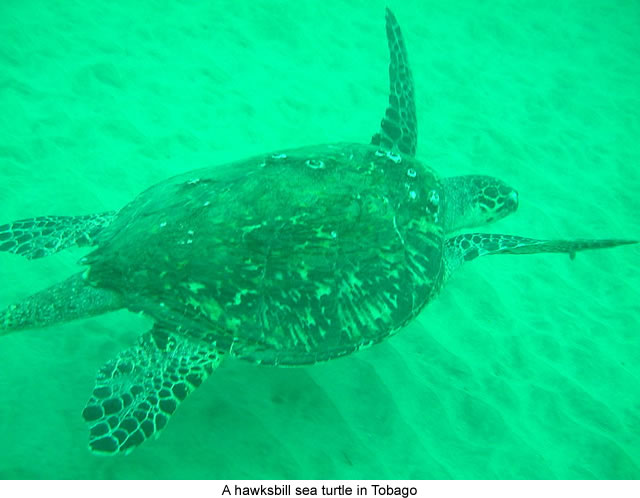 |
Canku Ota
|
 |
|
(Many Paths)
|
||
|
An Online Newsletter
Celebrating Native America
|
||
|
June 2014 - Volume 12
Number 6
|
||
|
|
||
|
Hawksbill Sea Turtle
(Eretmochelys imbricata) |
||
|
by From Wikipedia, the
free encyclopedia
|
||
|
The hawksbill's appearance is similar to that of other marine turtles. It has a generally flattened body shape, a protective carapace, and flipper-like arms, adapted for swimming in the open ocean. E. imbricata is easily distinguished from other sea turtles by its sharp, curving beak with prominent tomium, and the saw-like appearance of its shell margins. Hawksbill shells slightly change colors, depending on water temperature. While this turtle lives part of its life in the open ocean, it spends more time in shallow lagoons and coral reefs. Human fishing practices threaten E. imbricata populations with
extinction. The World Conservation Union classifies the hawksbill
as critically endangered. Hawksbill shells were the primary source
of tortoiseshell material used for decorative purposes. The Convention
on International Trade in Endangered Species outlaws the capture
and trade of hawksbill sea turtles and products derived from them.
Adult hawksbill sea turtles have been known to grow up to 1 m (3 ft) in length, weighing around 80 kg (180 lb) on average. The heaviest hawksbill ever captured was measured to be 127 kg (280 lb). The turtle's shell, or carapace, has an amber background patterned with an irregular combination of light and dark streaks, with predominantly black and mottled-brown colors radiating to the sides. Several characteristics of the hawksbill sea turtle distinguish
it from other sea turtle species. Its elongated, tapered head ends
in a beak-like mouth (from which its common name is derived), and
its beak is more sharply pronounced and hooked than others. The
hawksbill's arms have two visible claws on each flipper.
Hawksbill sea turtles' sand tracks are asymmetrical, because they crawl on land with an alternating gait. By contrast, the green sea turtle and the leatherback turtle crawl rather symmetrically. Due to its consumption of venomous cnidarians, hawksbill sea turtle flesh can become toxic. Distribution
Atlantic subpopulation
Indo-Pacific subpopulation The Philippines hosts several nesting sites, including the island of Boracay. A small group of islands in the southwest of the archipelago has been named the "Turtle Islands" because two species of sea turtles nest there: the hawksbill and the green sea turtle. In Hawaii, hawksbills mostly nest on the "main" islands of Oahu, Maui, Molokai, and Hawaii. In Australia, hawksbills are known to nest on Milman Island in the Great Barrier Reef. Hawksbill sea turtles nest as far west as Cousine Island in the Seychelles, where the species has been legally protected since 1994, and the population is showing some recovery. The Seychelles' inner islands and islets, such as Aldabra, are popular feeding grounds for immature hawksbills. Eastern Pacific subpopulation Habitat
Feeding Hawksbills are highly resilient and resistant to their prey. Some of the sponges they eat, such as Aaptos aaptos, Chondrilla nucula, Tethya actinia, Spheciospongia vesparium, and Suberites domuncula, are highly (often lethally) toxic to other organisms. In addition, hawksbills choose sponge species with significant numbers of siliceous spicules, such as Ancorina, Geodia (G. gibberosa), Ecionemia, and Placospongia. Life history Breeding The baby turtles, usually weighing less than 24 g (0.85 oz)
hatch at night after around two months. These newly emergent hatchlings
are dark-colored, with heart-shaped carapaces measuring around 2.5
cm (0.98 in) long. They instinctively crawl into the sea, attracted
by the reflection of the moon on the water (possibly disrupted by
light sources such as street lamps and lights). While they emerge
under the cover of darkness, baby turtles that do not reach the
water by daybreak are preyed upon by shorebirds, shore crabs, and
other predators. Maturity A series of biotic and abiotic cues, such as individual genetics, foraging quantity and quality or population density, may trigger the maturation of the reproductive organs and the production of gametes and thus determine sexual maturity. Like many reptiles, all marine turtles of a same aggregation are highly unlikely to reach sexual maturity at the same size and thus age. Age at maturity has been estimated to occur between 10 and 25 years of age for Caribbean hawksbills. Turtles nesting in the Indo-Pacific region may reach maturity at a minimum of 30 to 35 years. Evolutionary history Etymology and taxonomic history Two subspecies are accepted in E. imbricata's taxon. E. i. bissa (Rüppell, 1835) refers to populations that reside in the Pacific Ocean. The Atlantic population is a separate subspecies, E. i. imbricata (Linnaeus, 1766). The nominate subspecies is the Atlantic taxon, because Linnaeus' type specimen was from the Atlantic. Fitzinger derived the genus' name, Eretmochelys, from the Greek roots eretmo and chelys, corresponding to "oar" and "turtle", respectively. The name refers to the turtles' oar-like front flippers. The species' name imbricata is Latin, corresponding to the English term imbricate. This appropriately describes the turtles' overlapping posterior scutes. The Pacific hawksbill's subspecies name, bissa, is Latin for "double". The subspecies was originally described as Caretta bissa; the term referred to the then-species being the second species in the genus. Caretta is the genus of the hawksbill's much larger relative, the loggerhead turtle. Exploitation by humans Many cultures also use turtles' shells for decoration. These turtles have been harvested for their beautiful shell since Egyptian times, and the material known as tortoiseshell is normally from the hawksbill. In China, where it was known as tai mei, the hawksbill is called the "tortoise-shell turtle", named primarily for its shell, which was used for making and decorating a variety of small items, as it was in the West. In Japan, the turtles are also harvested for their shell scutes, which are called bekko in Japanese. It is used in various personal implements, such as eyeglass frames and the shamisen (Japanese traditional three-stringed instrument) picks. In 1994, Japan stopped importing hawksbill shells from other nations. Prior to this, the Japanese hawksbill shell trade was around 30,000 kg (66,000 lb) of raw shells per year. In the West, hawksbill sea turtle shells were harvested by the ancient Greeks and ancient Romans for jewelry, such as combs, brushes, and rings. The bulk of the world's hawksbill shell trade originates in the Caribbean. In 2006, processed shells were regularly available, often in large amounts, in countries including the Dominican Republic and Colombia. The hawksbill sea turtle appears on the reverse side of the Venezuelan 20-bolivar and the Brazilian 2-reais banknotes. A much-beloved fountain sculpture of a boy riding a hawksbill, affectionately known as Turtle Boy, stands in Worcester, Massachusetts. Conservation In 1982, the IUCN Red List of Threatened Species first listed E. imbricata as endangered. This endangered status continued through several reassessments in 1986, 1988, 1990, and 1994 until it was upgraded in status to critically endangered in 1996. Two petitions challenged its status as an endangered species prior to this, claiming the turtle (along with three other species) had several significant stable populations worldwide. These petitions were rejected based on their analysis of data submitted by the Marine Turtle Specialist Group (MTSG). The data given by the MTSG showed the worldwide hawksbill sea turtle population had declined by 80% in the three most recent generations, and no significant population increase occurred as of 1996. CR A2 status was denied, however, because the IUCN did not find sufficient data to show the population likely to decrease by a further 80% in the future. The species (along with the entire family Cheloniidae) has been listed on Appendix I of the Convention on International Trade in Endangered Species. It is illegal to import or export turtle products, or to kill, capture, or harass hawksbill sea turtles. Local involvement in conservation efforts has also increased in the past few years. The United States Fish and Wildlife Service and National Marine Fisheries Service have classified hawksbills as endangered under the Endangered Species Act since 1970. The US government established several recovery plans for protecting E. imbricata.
|
|
insert map here
|
|
|
||
|
|
||
| Canku Ota is a free Newsletter celebrating Native America, its traditions and accomplishments . We do not provide subscriber or visitor names to anyone. Some articles presented in Canku Ota may contain copyright material. We have received appropriate permissions for republishing any articles. Material appearing here is distributed without profit or monetary gain to those who have expressed an interest. This is in accordance with Title 17 U.S.C. Section 107. | ||
|
Canku Ota is a copyright ©
2000 - 2014 of Vicki Williams Barry and Paul Barry.
|
||
 |
 |
|
|
The "Canku
Ota - A Newsletter Celebrating Native America" web site and
its design is the
|
||
|
Copyright ©
1999 - 2014 of Paul C. Barry.
|
||
|
All Rights Reserved.
|
||
 The
hawksbill sea turtle (Eretmochelys imbricata) is a critically endangered
sea turtle belonging to the family Cheloniidae. It is the only extant
species in the genus Eretmochelys. The species has a worldwide distribution,
with Atlantic and Indo-Pacific subspecies—E. i. imbricata and
E. i. bissa, respectively.
The
hawksbill sea turtle (Eretmochelys imbricata) is a critically endangered
sea turtle belonging to the family Cheloniidae. It is the only extant
species in the genus Eretmochelys. The species has a worldwide distribution,
with Atlantic and Indo-Pacific subspecies—E. i. imbricata and
E. i. bissa, respectively. Anatomy
and morphology
Anatomy
and morphology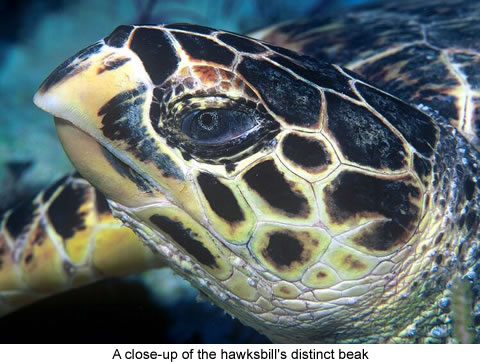 One
of the hawksbill's more easily distinguished characteristics is
the pattern of thick scutes that make up its carapace. While its
carapace has five central scutes and four pairs of lateral scutes
like several members of its family, E. imbricata's posterior scutes
overlap in such a way as to give the rear margin of its carapace
a serrated look, similar to the edge of a saw or a steak knife.
The turtle's carapace has been known to reach almost 1 m (3 ft)
in length.
One
of the hawksbill's more easily distinguished characteristics is
the pattern of thick scutes that make up its carapace. While its
carapace has five central scutes and four pairs of lateral scutes
like several members of its family, E. imbricata's posterior scutes
overlap in such a way as to give the rear margin of its carapace
a serrated look, similar to the edge of a saw or a steak knife.
The turtle's carapace has been known to reach almost 1 m (3 ft)
in length.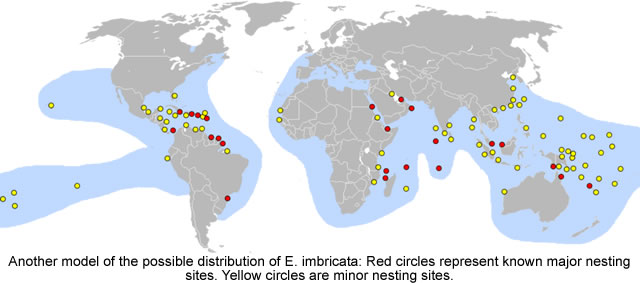
 In
the Caribbean, the main nesting beaches are in the Lesser Antilles,
Barbados, Guadeloupe, Tortuguero in Costa Rica, and in the Yucatan.
They feed in the waters off Cuba and around Mona Island near Puerto
Rico among other places.
In
the Caribbean, the main nesting beaches are in the Lesser Antilles,
Barbados, Guadeloupe, Tortuguero in Costa Rica, and in the Yucatan.
They feed in the waters off Cuba and around Mona Island near Puerto
Rico among other places.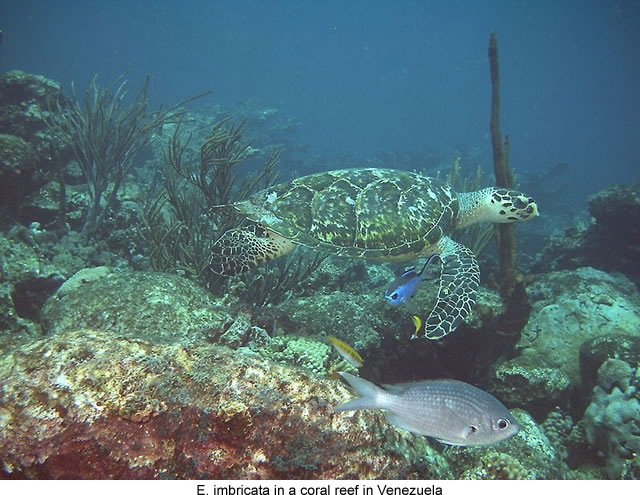
 Not
much is known about the life history of hawksbills. Their life history
can be divided into three phases, namely the pelagic phase, from
hatching to about 20 cm, the benthic phase, when the immature turtles
recruit to foraging areas, and the reproductive phase, when they
reach sexual maturity. The pelagic phase possibly lasts 1 to 4 yr.
Hawksbills show a degree of fidelity after recruiting to the benthic
phase, however movement to other similar habitats is possible.
Not
much is known about the life history of hawksbills. Their life history
can be divided into three phases, namely the pelagic phase, from
hatching to about 20 cm, the benthic phase, when the immature turtles
recruit to foraging areas, and the reproductive phase, when they
reach sexual maturity. The pelagic phase possibly lasts 1 to 4 yr.
Hawksbills show a degree of fidelity after recruiting to the benthic
phase, however movement to other similar habitats is possible. Early
life
Early
life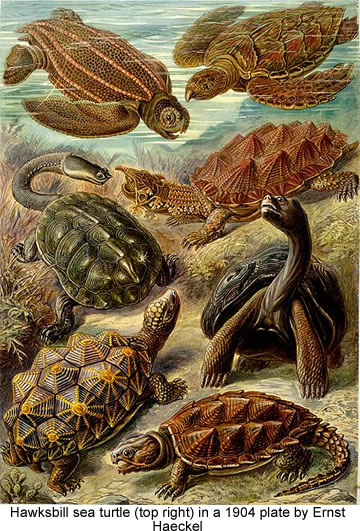 Within
the sea turtles, E. imbricata has several unique anatomical and
ecological traits. It is the only primarily spongivorous reptile.
Because of this, its evolutionary position is somewhat unclear.
Molecular analyses support placement of Eretmochelys within the
taxonomic tribe Carettini, which includes the carnivorous loggerhead
and ridley sea turtles, rather than in the tribe Chelonini, which
includes the herbivorous green turtle. The hawksbill probably evolved
from carnivorous ancestors.
Within
the sea turtles, E. imbricata has several unique anatomical and
ecological traits. It is the only primarily spongivorous reptile.
Because of this, its evolutionary position is somewhat unclear.
Molecular analyses support placement of Eretmochelys within the
taxonomic tribe Carettini, which includes the carnivorous loggerhead
and ridley sea turtles, rather than in the tribe Chelonini, which
includes the herbivorous green turtle. The hawksbill probably evolved
from carnivorous ancestors. Throughout
the world, hawksbill sea turtles are taken by humans, though it
is illegal to hunt them in many countries. In some parts of the
world, hawksbill sea turtles are eaten as a delicacy. As far back
as the fifth century BC, sea turtles, including the hawksbill, were
eaten as delicacies in China.
Throughout
the world, hawksbill sea turtles are taken by humans, though it
is illegal to hunt them in many countries. In some parts of the
world, hawksbill sea turtles are eaten as a delicacy. As far back
as the fifth century BC, sea turtles, including the hawksbill, were
eaten as delicacies in China.